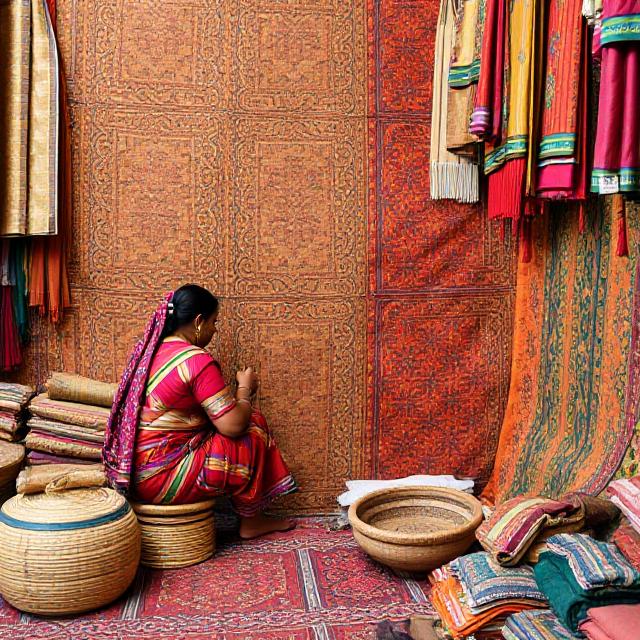India’s Textile Revolution: Unlocking MSME Potential for Global Leadership
The Textile Opportunity: India’s Path to Manufacturing Excellence
India stands at a critical juncture in its industrial evolution, where the textile sector emerges as a beacon of hope for massive job creation and economic transformation. The India textile industry MSME growth potential represents more than just manufacturing expansion—it embodies a vision of inclusive development that can lift millions out of poverty while establishing the nation as a global textile powerhouse.
The textile industry’s significance extends far beyond traditional manufacturing metrics. With the global shift toward manmade fibers commanding 70 percent of the international market, India faces both unprecedented opportunities and formidable challenges. The sector’s ability to generate employment across skill levels—from rural cotton farmers to urban garment workers—makes it uniquely positioned to address India’s demographic dividend.
However, realizing this potential requires a fundamental reimagining of how India approaches textile manufacturing jobs India creation. The current landscape reveals a concerning reality: Indian manufacturers face input costs that are 25 percent higher than global competitors, primarily due to protective duties and Quality Control Orders (QCOs) that inadvertently handicap domestic producers.
MSME: The Backbone of Textile Transformation
Micro, Small, and Medium Enterprises (MSMEs) form the architectural foundation of India’s textile ecosystem. These enterprises, scattered across spinning mills in Tamil Nadu, weaving clusters in Gujarat, and apparel manufacturing hubs in Karnataka, collectively represent the nation’s industrial resilience and entrepreneurial spirit.
MSME textile sector development encompasses thousands of businesses that employ millions of workers, often in semi-urban and rural areas where alternative employment opportunities remain limited. These enterprises demonstrate remarkable adaptability, having survived global economic downturns, technological disruptions, and competitive pressures from international manufacturers.
The spinning sector alone employs over 4.5 million people directly, with another 8-10 million dependent on this industry for their livelihoods. In states like Tamil Nadu and Maharashtra, textile MSMEs serve as economic anchors for entire districts, supporting not just direct employment but creating ripple effects across transportation, logistics, banking, and ancillary services.
However, MSME empowerment textiles requires more than just financial support or policy announcements. It demands a comprehensive ecosystem approach that addresses infrastructure bottlenecks, technology adoption barriers, and market access challenges that currently constrain these enterprises from reaching their full potential.
The Manmade Fiber Reality: Adapting to Global Trends
The global textile landscape has undergone a seismic shift over the past two decades. Manmade fiber manufacturing India must acknowledge that synthetic fibers now dominate international markets, driven by consumer preferences for durability, easy maintenance, and performance characteristics that natural fibers cannot match.
Polyester, nylon, and other synthetic materials have revolutionized everything from sportswear to home textiles. Countries like China, Vietnam, and Bangladesh have successfully capitalized on this trend, building integrated manufacturing ecosystems that span from petrochemical feedstock to finished garments.
India’s response to this transformation has been fragmented and often counterproductive. While the country possesses significant capabilities in petrochemicals and has established polyester manufacturing capacity, policy inconsistencies have prevented the emergence of a truly competitive synthetic fiber ecosystem.
The textile raw material costs India challenge becomes particularly acute when examining the manmade fiber segment. Import duties on key intermediates, combined with QCO requirements that often lack corresponding domestic capacity, create a perfect storm of cost disadvantages that ripple through the entire value chain.
Policy Reforms: Breaking Down Barriers to Competitiveness
The path toward global textile market competition requires bold policy interventions that prioritize competitiveness over protection. Current trade policies, while well-intentioned, often create unintended consequences that harm the very industries they seek to protect.
Quality Control Orders, originally designed to ensure product standards and prevent dumping, have evolved into complex regulatory mechanisms that increase compliance costs and create supply chain uncertainties. For MSME manufacturers operating on thin margins, these additional burdens can mean the difference between profitability and closure.
Textile industry policy reforms must embrace a more nuanced approach that balances legitimate quality concerns with competitive imperatives. This includes streamlining QCO procedures, reducing redundant testing requirements, and creating mutual recognition agreements with major trading partners.
Import duty rationalization represents another critical reform area. The current structure often protects downstream industries at the expense of upstream competitiveness, creating internal contradictions that benefit no stakeholder. A comprehensive review of the entire duty structure, focusing on effective protection rates rather than nominal tariffs, could unlock significant cost advantages for Indian textile value chain participants.
Technology Integration and Industry 4.0
The future of spinning weaving apparel MSMEs lies in embracing technological transformation while maintaining the human-centric employment model that makes textiles socially significant. Industry 4.0 technologies—automation, IoT sensors, data analytics, and artificial intelligence—offer unprecedented opportunities to enhance productivity while creating new categories of skilled employment.
Digital transformation in textile MSMEs goes beyond just installing new machinery. It encompasses supply chain digitization, demand forecasting, quality management systems, and customer relationship platforms that can help small manufacturers compete with larger rivals.
The challenge lies in making these technologies accessible and affordable for enterprises with limited capital resources. Government initiatives, industry associations, and technology providers must collaborate to create financing mechanisms, training programs, and implementation support systems that democratize access to advanced manufacturing technologies.
Employment Generation and Inclusive Growth
Textile sector employment generation represents one of India’s most promising pathways to addressing unemployment and underemployment challenges. Unlike many other manufacturing sectors that have become increasingly capital-intensive, textiles retain their labor-intensive character while offering opportunities for skill development and career progression.
The sector’s employment potential extends across the entire skills spectrum. Rural areas benefit from cotton cultivation, ginning, and basic processing activities. Semi-urban locations house spinning mills, weaving units, and dyeing facilities that employ both skilled technicians and semi-skilled operators. Urban centers concentrate on design, marketing, and high-value manufacturing activities that require advanced skills and education.
Women constitute a significant portion of textile employment, particularly in garment manufacturing and handicrafts segments. MSME textile sector development initiatives must prioritize gender-inclusive policies that address workplace safety, skill development, and career advancement opportunities for women workers.
Global Supply Chain Integration
India’s textile ambitions cannot be realized in isolation from global supply chain dynamics. The textile export potential India depends on the country’s ability to integrate seamlessly into international production networks while maintaining cost competitiveness and quality standards.
Recent global events—from the COVID-19 pandemic to geopolitical tensions—have highlighted the importance of supply chain diversification. International buyers increasingly seek alternatives to concentrated manufacturing bases, creating opportunities for countries that can offer reliable, cost-effective production capabilities.
However, integration into global supply chains requires more than just competitive pricing. It demands consistent quality, reliable delivery schedules, compliance with international standards, and the ability to scale production quickly in response to market demands.
Infrastructure and Logistics Excellence
Fiber production competitiveness and overall textile sector success depend heavily on infrastructure quality and logistics efficiency. Transportation costs, power reliability, water availability, and digital connectivity all significantly impact manufacturing competitiveness.
The government’s focus on infrastructure development through initiatives like the National Infrastructure Pipeline provides opportunities to address long-standing bottlenecks. However, textile-specific infrastructure needs—specialized industrial parks, common effluent treatment facilities, testing laboratories, and design centers—require targeted attention and investment.
Logistics costs in India remain significantly higher than major competing countries, partly due to fragmented transportation networks and regulatory complexities. Streamlining inter-state movement, implementing GST reforms effectively, and developing multimodal transportation networks can substantially reduce these cost disadvantages.
Financial Inclusion and Capital Access
Small scale textile manufacturing enterprises often struggle with capital access challenges that limit their growth potential and technological upgrading capabilities. Traditional banking systems, while supportive, may not fully understand the seasonal nature of textile business cycles or the collateral limitations faced by MSME entrepreneurs.
Alternative financing mechanisms—supply chain financing, invoice discounting, equipment leasing, and venture debt—offer promising solutions for addressing capital constraints. Financial technology platforms can bridge information gaps between lenders and borrowers while reducing transaction costs and processing times.
Government schemes like the Technology Upgradation Fund Scheme (TUFS) and various MSME support programs provide valuable support, but their implementation often suffers from bureaucratic delays and complex procedures that discourage eligible enterprises from participating.
Sustainability and Circular Economy
Modern textile industry infrastructure must incorporate sustainability principles from the design stage itself. Environmental concerns, resource scarcity, and consumer awareness are driving demand for sustainable textile production processes and products.
Circular economy principles—reducing waste, reusing materials, and recycling fibers—offer both environmental benefits and cost advantages for textile manufacturers. MSMEs that adopt sustainable practices early can differentiate their products in international markets while reducing long-term operational costs.
Water management, chemical usage optimization, and energy efficiency improvements represent immediate opportunities for both environmental impact reduction and cost savings. Common facilities and shared resources can help MSMEs access advanced environmental technologies that individual enterprises might not afford independently.
Skill Development and Human Capital
The success of India textile industry MSME growth ultimately depends on human capital quality and continuous skill development initiatives. Rapid technological changes require workers who can adapt to new processes, operate advanced equipment, and contribute to innovation and quality improvement efforts.
Collaboration between industry, educational institutions, and government agencies can create comprehensive skill development programs that address both current needs and future requirements. Apprenticeship programs, on-the-job training initiatives, and continuous learning platforms can help workers stay relevant in an evolving industry landscape.
Design and innovation capabilities represent particular areas where India needs strengthening. While the country excels in manufacturing execution, developing indigenous design capabilities and fashion sensibilities can help capture higher value segments in global textile markets.
Conclusion: Realizing the Textile Dream
India’s textile sector stands poised for unprecedented growth, but realizing this potential requires coordinated action across multiple dimensions. Manufacturing job creation through textile industry expansion can drive inclusive economic growth while establishing India as a global manufacturing leader.
The path forward demands policy courage, industry innovation, and collaborative partnerships that align all stakeholders toward common objectives. MSMEs must be empowered not just as production units but as innovation engines and employment generators that contribute to national economic transformation.
Success in this endeavor will be measured not just in export revenues or production volumes, but in the millions of lives transformed through meaningful employment opportunities, skill development, and entrepreneurial success stories that emerge from India’s textile revolution.
The opportunity is immense, the challenges are surmountable, and the time for action is now. India’s textile future depends on the choices made today—choices that prioritize competitiveness, embrace innovation, and never lose sight of the human dimension that makes this industry uniquely positioned to drive inclusive economic growth.












